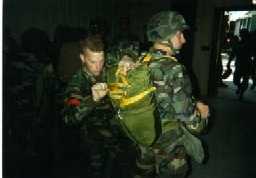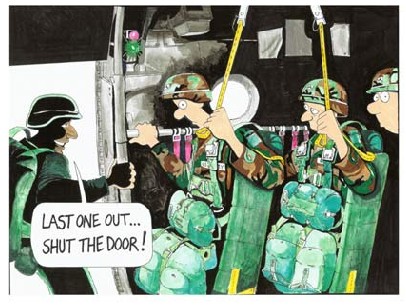
RIGGERS DESERVE OUR RESPECT AND ADMIRATION
THE FORT BRAGG POST

The recent report of damaged parachutes probably has something to do with the fact that each Rigger now packs 25-30 parachutes a day on an around-the-clock basis--an endless treadmill. Some have packed over 5,000 in a very short period of time without a single complication of any kind! Without Riggers there would be no Airborne operation. Those who jump are the "takers" while the "givers" shake out, untangle, repair and repack each parachute, which must work properly since there is a life depending on it. There has been a long history of Riggers saving the day with the timely airdrop of badly needed supplies in the nick of time!.
On top of this responsibility, to have an entire 82d Airborne Division and XVIII Airborne Contingency Corps ready to jump on an 18-hour notice, is the constant rigging to keep each trooper jumping on jump status and rigging heavy drop vehicles/supplies. Rather than being grateful, some of the "takers" scoff at the Riggers; they want to feel superior since Riggers are "support". If it was up to me I'd officially ban the word "support" from the military vocabulary as a description for type of units, replacing it with a more accurate word like "Strength" or "Sustainment".
C-130 combat veteran Sam McGowan writes:
"The Loadmaster position on Air Force transports has a direct connection to the U.S. Army rigging field. During the early part of World War II personnel in laundry companies in the headquarters units of USAAF groups in New Guinea and India were given responsibility for rigging both parachutes and loads for airdrop. I am in contact with a retired USAF major who was a warrant officer working in supply in Australia in 1942. He came up with the idea of using metal containers designed to transport icecream to airdrop supplies to Australian troops fighting along the Kokoda Track in New Guinea. The Aussies began calling the USAAF C-47s 'Biscuit Bombers' as they kept them resupplied with food and and ammunition during the campaign. As the war continued the rigging field was expanded and rigging personnel began flying as 'Dropmasters' with transport - and sometimes bomber - crews who were dropping supplies. This practice continued through the Korean War, where Army Riggers were solely responsible for rigging the airdrop systems on the Air Force C-119s and also for inflight duties. The present-day system of using USAF Loadmasters on transport crews is of fairly recent origin, and is a by-product of developments in U.S. Army and U.S. Air Force Airborne and Airlift operations during the latter half of the 1950s and the early 1960s."
Every Paratrooper who has anything but thanks/admiration for Riggers needs to take a parachute tangled in bushes and try to pack it properly as coached by an instructor. Every Paratrooper should actually pack--not watch--a tangled parachute for familiarization training, at the company unit level. We all need to thankfull we don't have to pack our own parachutes as the Paratroopers from the past had to just before combat jumps. We could begin showing our respect by using a capital "R" when using the NAME "Rigger".
When Airborne was in its infancy, every Paratrooper packed his own parachute until accidents and training time loss gave riggers the sole responsibility--Russian Paratroops pack their own round parachutes in the field. Thousands of sport parachutists pack their own ram-air parachutes in a matter of minutes before each jump--sometimes several times in a day right on the pick-up/drop zone.
We need to have every Paratrooper, Rigger and commander who cares about the future of the U.S. Airborne to write to U.S. Army Natick Labs and Infantry School and insist that the new T-10D or "T-21" parachute be "Rigger friendly," ie. Easily field packed without tools or supplies in minutes with the reserve integral to the back so in the event of a total malfunction, ribs and spines are not broken from opening shock pressures on the chest. Hanging from your chest reserve is awkward and exposes the lower back/spine to severe impact injuries.

Handling thousands of separate chest reserves and packing them severely burdens Riggers and complicates the safety and combat power of the Airborne operations--a clean front T-10D or T-21 with inside pack tray pouch for kit bag is less likely to snag on exit so jumpers don't get towed, and would increase the number of Paratroopers who can be carried onboard each USAF plane to deliver the same number that can be air landed.
One of the reasons why the Airborne is stuck in a 1940's "time-warp" of obsolete parachute technology is that our Riggers are bogged down as "work-slaves" in order to keep packing/maintaining the inefficient systems now in use. Finally things are changing due to the dedication of Riggers who have dedicated their lives to the improvemnent of air delivery means; we salute them!
Riggers should be the true subject-matter experts in the science of parachuting when they leave Ft. Lee, Virginia AIT--they must be able to rig ram-air parachutes, oxygen systems and automatic activation devices so they can support RAP HALO/HAHO operations of Corps/Division Long Range Surveillance Units and broaden their skills/knowledge beyond the status guo.
Since the U.S. Army Special Forces Military Free-fall Course has moved to Yuma, Arizona, Fort Bragg could hold an abbreviated MFF Course during a good-weather month for all Soldiers--especially Riggers who earn their civilian free fall "C" license using their own funds. This would save the U.S. Army money, increase service wide expertise and morale, and move the Airborne forward into modern parachuting technologies.

Riggers could be then rewarded with MFF wings--not just give endlessly--and their "Rigger badge/wings" could mean what it says--they truly could pack any parachute in U.S. Army service.
U.S. Army Rigger wings--with a long, illustrius history by their own right--- should be worn over basic Airborne wings to signify the advanced skills of a Rigger--commanders who care about Rigger morale could write in to the U.S. Army uniform board requesting this policy change. The fact that they cared would do wonders for morale.
Another thing leaders can do is make sure Riggers get to jump from as many types of aircraft as possible: CASA 212s, UV-18 Twin Otters, C-47s (DC-3s), Cessna Skywagons, C-17 Globemaster IIIs and water jumps whenever possible. If you are a jumper you can say "thank you" every time you see a Paratrooper with Rigger's wings on his BDU. Leaving a dollar bill in your kit bag after every jump doesn't seem like a bad idea, either. We do similar customs when an officer hands a silver dollar to the first person that salutes him, why not the one who saved your life?
This isn't "politically correct touchee-freely"--this is what Generals Ridgway and Gavin did or would do today--the Airborne is US not "them and US." This isn't about Riggers being overly sensitive (thin-skinned) to criticism.
I've heard Paratroopers "trash-talk" Riggers since the former believes that since they may jump into a combat zone while Riggers pack parachutes in the so-called safer "rear" and that only they should be worthy of the maroon beret/respect of a Paratrooper. This is selfish and short-sighted. While Riggers "bust tail" daily to keep infantry Paratroopers jumping, they jump continually and share the same peacetime risks. In combat, Riggers jump in to recover heavy drop air items and bundles, so this snobbery is not justified even by selfish logic.
If Paratroopers think rigging is such an easy, comfortable job, we could start having them pack their own parachutes if an improved T-10D or T-21-type is fielded and see how they like it. Having Riggers increases the safety of each "great Paratrooper" and frees him to train/focus on his battlefield mission.
This is a trade-off real leaders make in the real world. Those who want to ridicule Riggers need to let reason prevail over ego-centered emotion or, failing that, put in for a transfer to a 92-series Rigger MOS if packing parachutes is such an "easy" job. While the Paratroopers waited for the word to go, Riggers were dropping food, blankets and medical supplies to the besieged, starving people of Bosnia during Operation Provide Promise.
We need to push together to improve the Airborne operation--better parachutes would enable us to have more "trigger-pullers" jumping into battle and less "tail" in the rear, whose "safety" is increasingly questionable on the modern non-linear battlefield subject to terrorists, ballistic missile and Special Forces infiltration attack. If you want someone to respect you, be unselfish and hard-working--like the U.S. Army's Riggers.
WHO PACKED YOUR PARACHUTE?
Sometimes in the daily challenges that life gives us, we miss what is really important. We may fail to say, hello, please or thank you, congratulate someone on something wonderful that happened to them nice for no reason, Charles Plumb, a U.S. Naval Academy graduate, was a jet fighter in Vietnam. After 75 combat missions, his plane was destroyed by a surface-to-air missile. Mr. Plumb ejected and parachuted into enemy hands, He was captured and spent six years in a communist Vietnamese prison. He survives the ordeal and now lectures on lessons learned from that experience.
One day, when Mr. Plumb and his wife were eating in a restaurant, a man at another table came up and said, :you're Plumb! You flew jet fighters in Vietnam from the aircraft carrier Kitty Hawk. You .were shot down!?
"How in the world did you know that?" asked Mr. Plumb. "I, packed your parachute." the man replied.
Mr. Plumb gasped in surprise and gratitude him, "It sure did, if your chute hadn't worked, I wouldn't be here today."
Mr. Plumb couldn't sleep that night, thinking about that man. Plumb says, "I kept wondering what he might have looked like in a navy uniform: a white hat, a bib in the back, and bell bottom trousers. I wonder how many times I might have seen him and not even said good morning, how are you or anything because, you see , I was a fighter pilot and he was 'just a sailor'."
Mr. Plumb thought of the many hours the sailor had spent on long wooden tables in the bowels of the ship , carefully weaving the shrouds and folding the silks of each parachute, holding in his hands each time the fate of someone he didn't know.
Now, Mr. Plumb asks his audience, "Who's packing your parachute?"
Everyone has someone who provided what they need to make it through the day.
Mr. Plumb also pointed out that he needed many kinds of parachutes when his plane was shot down over enemy territory;he needed the psychological parachute, his mental parachute, his emotional parachute, and his spiritual parachute. He called on all of these supports before reaching safety. His experience reminds all of us to prepare ourselves to weather whatever storms are ahead.
As you go through this week, this month, this year...recognize people who pack your parachute!

 Return to U.S. Army Airborne Equipment Shop outside frame
Return to U.S. Army Airborne Equipment Shop outside frame